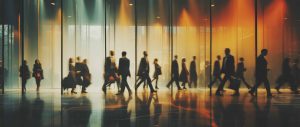Asiakaskokemus on yrityksille jatkuvasti tärkeämpi kilpailuvaltti. Rajattomien vaihtoehtojen ja alati kiristyvän kilpailun maailmassamme menestyksellä erottautuvat ne yritykset, jotka pystyvät vastaamaan…
Towards Sustainable Higher Education Institutions in Tanzania: SUSIE Project Experiences
Introduction
Dear Reader,
The SUSIE project warmly welcomes you to read this publication, which presents some of the remarkable results of the extensive collaboration. The four-year development project of the universities of the Global South and North has operated within a complex development context. Characteristics of these are that the progression from cause to effect eventually follows a logical order, although logic becomes apparent only later through decision making analysis (see Chapter 1). In addition, the uniqueness of each project makes replication impossible, so it is difficult to find predefined solution models, and all starts from scratch. This publication is a lens through which the reader can view the complex development process and its results in a compact form.
SUSIE, Sustainable Business and Employability through HEIs’ Innovation Pedagogy, was comprised three Tanzanian HEIs — Tumaini University Dar es Salaam College (TUDARCo), now Dar es salaam Tumaini University (DarTU), Moshi Co-operative University (MoCU), and Mwenge Catholic University (MWECAU) — alongside the Finnish Turku University of Applied Sciences (Turku UAS), which served as the project coordinator. The consortium did not arise from the vacuum, but the foundation rests on former development initiatives during which partners had not only established confidential relationships but also invested in capacity building (Chapter 3). This basement enabled SUSIE to set ambitious goals and follow capacity building as defined by the United Nations, UN:
Capacity-building is defined as the process of developing and strengthening the skills, instincts, abilities, processes, and resources necessary for organizations and communities to not only survive but also adapt and thrive in a rapidly changing world. Central to capacity building is a form of transformation that emanates from within, extending beyond mere task performance to encompass shifts in mindsets and attitudes.
The UN recognizes universities as key enablers of capacity building, particularly through research, development, and innovation (RDI) initiatives that empower communities and societies to pursue sustainable development goals (SDGs). While SUSIE remained dedicated to all SDGs, the project identified SDG 4 Quality Education, SDG 5 Gender Equality, SDG 8 Decent Work, and SDG 9 Innovation as its cornerstones (Chapter 1).
As shown in Figure 1, the project comprised three operational areas, within which, activities related to their content were implemented. In the action area of Sustainable Leadership and Strategic Thinking (Chapter 1 and 2), the focus was on developing institutional capacities with forward-looking approaches and relevance. The second activity area, Enhanced Relevance and Pedagogical Competence (Chapter 3,4 and 5), prioritized pedagogical proficiency by improving teaching competence, emphasizing a student-cantered approach, and integration with working life. Simultaneously, the third result area, Improved Accessible and Interactive Learning Environments (Chapter 4 and 5), concentrated on strengthening the capacity of learning environments. More specifically, this involved expanding learning opportunities beyond traditional classrooms to open spaces and digital platforms. The outcome of SUSIE was achieved through mentioned three action areas, collectively driving transition and ensuring more accessible, relevant, and socially, economically, and environmentally sustainable higher education.
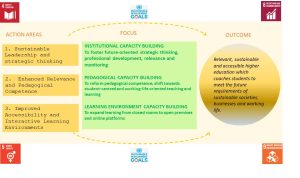
Figure 1. The action areas, focus and outcome of SUSIE.
Acknowledgements
The SUSIE project has been blessed by highly motivated team members and committed institutions, yet without the backing of extensive networks and stakeholders, its efforts had remained modest.
Firstly, the project would like to extend its deepest appreciation to the Ministry for Foreign Affairs of Finland and the Finnish National Agency for Education, without whose funding through the Higher Education Institutions Institutional Cooperation Instrument (HEI ICI), the project’s goals for sustainable capacity building would never have materialised. SUSIE acknowledges the efforts of the HEI ICI team, particularly Ms. Kaija Pajala, who has patiently provided extensive assistance to the SUSIE team. The eight projects within the HEI ICI family have been significant peer supporters and encouragers. Specifically, SUSIE wants to express sincere gratitude to the GeoICT4e project for its invaluable support and friendship, upon which SUSIE has relied, regardless of the nature of the issue.
SUSIE is deeply indebted to the institutions behind the partnership. The project is extremely grateful to Turku University of Applied Sciences, Moshi Co-operative University, Mwenge Catholic University, and Tumaini University of Dar es Salaam College, which have supported the project, closely followed its efforts, and provided comprehensive assistance, addressing needs regardless of their scale or nature, abstract or concrete. Beyond this, these institutions have demonstrated profound belief in the project and serious interest in its progress. Your unparalleled support has formed the cornerstones of the project.
The SUSIE board, CEO Paula Fontell, Ethica; Dr Blandina Kilama, President’s Office; Dr Eugene Lyamtane, DVCAF MWECAU; DVC ARPE Prof. Andrew Mollel, DarTU; CEO Jumanne Mtambalike, Sahara Ventures; CEO Aika Robert Nkya Shujaa Tours; Prof. Alfred Said Sife, VC MoCU and Dr Vesa Taatila, Rector-President Turku UAS, has proven to be the real dream team! Board members have not only fulfilled their duties but also consistently advised the project, provided direction during challenging periods, and facilitated networking with various stakeholders. Their unwavering guidance and constructive criticism have been fundamental in achieving goals and going further. In addition, exceptional professionals have stood by SUSIE. Sahara Ventures, thank you so much! You have been exemplary in your tireless support, not only for the project but also for stakeholders and students, demonstrating a holistic, curious, and forward- looking innovative attitude that has been invaluable. SUSIE extends profound gratitude to Dr. Petri Uusikylä whose curious and innovative mindset has offered endlessly new perspectives which have enriched and highly benefited the project’s actions, thinking, and outcomes. SUSIE is also grateful for the high proficiency of Zaidi Recyclers, which has nurtured the project and facilitated the transition from theory to practice. Millions thanks to Ehica for its visionary thinking, which has motivated SUSIE to transcend the conventional. It has been a great honour collaborating with all of you!
Without the colleagues and students of partner institutions, SUSIE would not have succeeded. Dear colleagues, words cannot express our gratitude for your patience and participation. Thank you for dedicating your precious time to various events and trainings organised by the project. The continuous discussions about SUSIE on campus were undoubtedly exhausting, yet you encouraged and motivated SUSIE to continue. To all students, you have been amazing! Your positive attitude and motivation to learn cannot be overstated. You inspired us to continue, and we thank you for showing us that sustainable transformation is indeed achievable!
People are the driving force behind human action. SUSIE extends its heartfelt thanks and deepest gratitude to every individual who participated in project activities, shared their views, and contributed to building capacity that enhances higher education, the working life, and the future of graduates.
Acronyms and abbreviations
COSTECH Tanzania Commission for Science and Technology
COVID Corona Virus Disease
HEI Higher Education Institutions
HESLB Higher Education Students’ Loans Board
ICT Information and Communication Technology
ILO International Labour Organization
IRIS Introducing Reverse Innovation to Higher Education Institutions In Tanzania
KAB Know About Business
MoCU Moshi Cooperative University
MWECAU Mwenge Catholic University
NACTE-VET National Council of Technical Education and Vocational Education in Tanzania
NICHE Netherlands Initiative for Capacity Building in Higher Education
NORAD Norwegian Agency for Development
OUT Open University of Tanzania
SDG Sustainable Development Goals
SUSIE Sustainable Business and Employability through Higher Education Institutions in Tanzania
TIE Tanzania Institute of Education
Turku UAS Turku University of Applied Sciences
TUDARCo Tumaini University Dar es Salaam College
UDIEC University of Dar es Salaam Innovation and Entrepreneurship Centre
UNIDO United Nations Industrial Development Organization
Sustainable Leadership and Transformation of Higher Education Institutions
Introduction
Higher Education Institutions (HEIs) are complex systems tasked with educating individuals and advancing science, knowledge and culture. As societal expectations evolve, there is a growing demand for HEIs to play a more significant role in addressing common issues. Sustainable leadership has emerged as a strategic approach aimed at fostering positive transformation, developing social capital and nurturing an innovative environment for the future.
Tanzania’s population ranks among the world’s fastest growing; it currently stands at 65 million, with approximately 70% aged between 15 and 35. The National System of Innovation has emphasised the increasingly active role HEIs should play in sustainable development. This underscores the importance of institutions investing in holistic strategic thinking, facilitating knowledge exchange beyond organisational boundaries and fostering the development of environmentally and socially responsible practices.
SUSIE, or Sustainable Business and Employability through HEIs’ Innovative Pedagogy, is a capacity-building project which aims to enhance strategic thinking, pedagogical competence and interactive learning spaces within Tanzanian universities. Serving as a crucial component in a series of initiatives focused on community learning and addressing local needs, this project plays a vital role in fostering sustainability.
This chapter focuses on the Sustainable Leadership Training Course, a one-year programme organised by the SUSIE project and offered to Tanzanian university leaders and managers. It delves into the systems change approach underpinning the training, while also introducing the concept of sustainable leadership as pivotal for organisations to contribute to societal resilience. Additionally, the chapter explores sustainable thinking as outlined within the SUSIE project in the context of sustainable leadership.
Systems change approach to developing HEIs in Tanzania
The urgency of many global policy concerns such as climate change, the green transition and social sustainability requires that more focused attention be paid to the connections between knowledge generation, educational strategies and curricula, and higher education policy formulation. In particular, the sustainability agenda compels us to adopt improved practices that anticipate and consider future developments. We interpret this transition as a shift from a conventional linear model of knowledge dissemination to a systems-driven model. The new approach is characterised by a forward-looking, anticipatory and ecosystemic perspective. In this model, support is provided to individuals, institutions and systems based on their overall engagement within the system, rather than focusing on specific stages or nodes in a policy cycle (Hopkins et al., 2021).
Tanzania’s higher education system has developed in a positive direction over the past ten years. In universities, strategic thinking has strengthened and the focus in curriculum design has shifted from traditional lecture-and-exam teaching to a more applied and student-inclusive approach. This has been clearly visible during Finland’s Higher Education Institutions Institutional Cooperation Instrument, HEI ICI, funded SUSIE and IRIS projects. The enhanced cooperation network between universities and their key stakeholders (a key focus of the IRIS project, along with innovative pedagogy) has been particularly noteworthy. The central focus of the SUSIE project has been to include an emphasis on sustainable leadership as part of the strategic development of universities.
Still, the existing institutional frameworks of contemporary research, including the academic publication system, career paths, departmental hierarchies and the standards for assessment and funding, sometimes fail to provide adequate support for innovative methods of generating knowledge. However, there is a growing demand for these new methods to align with the requirements of sustainability and the shift towards environmentally friendly practices in many policy areas. The transition from providing information to putting it into action, and ultimately to re-evaluating and redesigning, has been taking place for a considerable time. The dominant principles now progressively prioritise the transition from being responsible for outcomes to achieving significant effects, and potentially even to anticipating future developments, collaborating in the creation process and collectively making sense of situations.
The emergent approach to the strategic steering of Tanzanian universities is driven by ecosystems, where the provision of and demand for knowledge and the ways it is shared are becoming more complex and forward-looking. This method sets the stage for “anticipatory governance” in a broader context. In examining this change, we concentrate on the trust that exists within the government, evidence and knowledge, citizens, institutions and organisations. At the SUSIE project we aim to establish “systems navigation” as the method through which the shift from relying solely on expert- based scientific advice to a more comprehensive approach that emphasises systems and solutions takes place. This approach involves more collaborative, shared and open sense-making processes, enabling all participants in the governance system to bypass unnecessary hierarchies and sectoral obstacles. As a result, they can arrive at more suitable policy solutions in an increasingly intricate policy landscape.
The long-term development of Tanzania’s higher education system should be seen as a systemic transformation instead of a linear development path, where many social and socio-technical forces of change affect the emergence of new operating models and cultures.
Systemic change can be investigated from the standpoint of the factors and situations that enable change. John Kania, Mark Kramer and Peter Senge (2018) have identified six factors that condition systemic change, which are structured into three levels of change. The structural level of systemic change consists of operational principles, operational practices and resources. The structural level is concretised on the one hand as society’s institutions, management practices and regulatory solutions that enable and limit the interaction of actors. On the other hand, the question concerns the distribution and allocation of material and immaterial resources. At the level of relational change, relationships, interactions and power dynamics influence systems change. The number of relationships and the quality of connections has a decisive role on what kind of influences we are exposed to at any given time. At the level of transformative change, the core factor is the mental models of individuals, i.e., those deeply rooted habits that make us take things for granted and that guide our thinking, what we do and what we say.
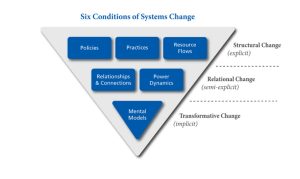 Figure 1. Six Conditions of Systems Change (Kania et al., 2018).
Figure 1. Six Conditions of Systems Change (Kania et al., 2018).
According to Gregory Bateson (1972), knowledge in social systems is not transmitted passively. Learning takes place when we assign meanings to signals and convert them into information and knowledge. The latter transformation can be called a “difference that makes a difference” to the recipient of that information. Learning is the process of marking these differences. Therefore, mental models, relationships and structural factors all have a simultaneous effect on systemic change. The challenge of the anticipatory governance approach is to connect these to the basic assumptions of the model and define the way in which the dynamics of change can be understood as part of a complex decision-making process.
In the discussions held during the training programmes and workshops of the SUSIE project, a position was taken on the ability of the three participating universities (Moshi Cooperative University (MoCU), Tumaini University Dar es Salaam College (TUDARCo) and Mwenge Catholic University (MWECAU)) to change, their desire to reform and the possibilities of systemic change. All of the participating universities had a clearly identified desire to reform and develop and to apply the approach of the Sustainable Leadership programme. Regarding the ability to change, the participants were positive: although there were differences in the starting levels (above all, with regard to heterogeneity), the belief in the ability to change was strong.
Regarding relational change, there were clear differences between strengthening networks and changing power structures. While cooperation between the universities has already improved enormously during the SUSIE project, changing power structures was found to be significantly more difficult. The latter concerns the traditional management and operating culture, the path dependency caused by which slows down the implementation of change. Above all, the rigidity of power relations can be seen in the relationships between the universities’ administration/top management and developers. Furthermore, the institutional rigidities of the entire education system in terms of teaching plans, funding and the low delegation of decision-making power may cause slowdowns. The latter belong to the highest, i.e., the structural, level of the model. In this regard, the change programme calls for macro-level structural reforms which will affect the entire Tanzanian higher education system.
Sustainable Leadership
According to Dos Santos and Ahmad (2020), sustainable development is characterised by dynamism and complexity.This implies that organisations aspiring to address sustainable development challenges must be not only capable, competent and high-performing but also have leadership which is committed to promoting sustainable development. In the late 1980s, the Brundtland Commission made a link between sustainable development and leadership, from the perspective of a future where environmental and human needs coexist. This line of thinking has since evolved, with Hargreaves and Fink (2004) associating sustainable leadership with educational institutions and introducing seven principles that denote the characteristics of sustainable leadership as follows:
- Fostering continuous learning
- Pursuing long-term success
- Embracing communicative and inclusive decision-making
- Advocating for social justice
- Respecting human and material resources
- Promoting diversity
- Engaging with the community
The year 2015 marked a significant global milestone in sustainable thinking with the launch of the United Nations’ Sustainable Development Agenda 2030. While national commitment to the 17 Sustainable Development Goals (SDGs) is significant, integrating various organisations into the agenda was recognised as imperative for concrete actions to be taken (Cesário et al., 2022).
At the organisational level, Liao (2022) underscored the importance of sustainable leadership as an essential concept when it comes to translating SDG thinking into actionable strategies. By fostering strategic competence and promoting an organisational culture that embraces sustainable thinking, leaders can ensure that sustainable approaches are ingrained within their organisation. However, this requires leaders to have strong commitment, a long-term strategic vision and the willingness to invest in shared decision-making and innovation.
Within the framework of sustainable leadership, the value of human resources is key. Additionally, responsible people-management practices prioritise employee well-being and competence development (Avery and Bergsteiner, 2011b). Liao (2022) argues that the sustainable leadership approach seeks resilience through continuous learning, achieving long-term success, promoting social justice and meeting stakeholder needs while maintaining economic, social and environmental balance.
Outlining sustainable thinking
The theory of change and the concept of sustainable leadership within the SUSIE project are discussed above. This section, in turn, concentrates on sustainable thinking which underpins the Sustainable Leadership training. This perspective is grounded in the SDGs, which serve as basic principles for advancing sustainability within higher education. The overall aim is to encourage HEIs to invest in the common goals so that institutions are seen as stable operators which produce culturally, socially, economically and environmentally sustainable competencies and knowledge. Rather than understanding sustainability as the subject matter of a particular course or programme, we propose that sustainability be built into HEIs and function as a guiding principle of institutions. Four SDGs—Quality Education, Gender Equality, Decent Work and Innovation—are extensive and provide an excellent backbone for educational institutions. These may steer universities towards long-term strategic planning, encourage them to foster interaction with society, motivate them to scan the signals from the environment and follow global change drivers. Success with regard to these SDGs requires professional management, with a holistic view of HEIs as essential enablers of positive transformation.
Figure 2 is a simplified model of a university, illustrating the intense interaction between university operators: the domain of Management and Administration is on the left side and the domain of Teaching and Learning is on the right side. In the Management domain, four key sectors are highlighted: Community Well-Being and Professional Development, Future Visions and Strategies, Transparency and Quality Assurance, and Innovativeness and Openness. Similarly, in the Teaching and Learning domain four approaches are outlined: the pedagogical approach, the competence approach, the curriculum approach and the innovation approach. The two domains are intricately linked by strategic guidelines which significantly influence all university operations including teaching and learning. Implicitly, society and working life are included in the image. The transparency and innovativeness of universities encourages working life initiatives and the integration of identified community needs into the learning process.
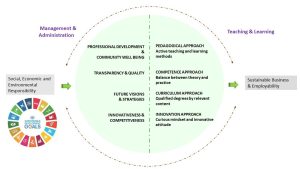
Figure 2. Sustainable Thinking, SUSIE Project.
The objective of the Teaching and Learning domain is to facilitate sustainable learning, characterised by a forward-looking curriculum that aims to cultivate relevant competencies through active pedagogy methods, innovative approaches and appropriate content. Achieving this requires strong motivation among teaching staff, which management should support by ensuring their well-being and providing opportunities for professional development. Consistency in leadership is not only about following a plan but also about being reliable, predictable and trustworthy. Budget planning and financial oversight are significant factors for HEIs. In terms of risks, funding is acritical factor for universities which requires active exploration of external innovation funding sources. Externally funded Research, Development and Innovation projects provide HEIs with a huge number of opportunities such as new partnerships, updated skills and knowledge, increased relevance and improved capacities.
A HEI is typically a large and diverse community, with members numbering in the thousands when students are included. Effective leadership of an extensive institution necessitates long-term strategic planning capabilities to steer the organisation towards desired futures. The concept of performance-based management highlights quality processes which establish targets and monitor achievements, primarily evaluating how well strategic areas are being executed. The theory of change serves as a roadmap which illustrates how initiatives are expected to yield outcomes and impacts, while also uncovering underlying assumptions regarding the mechanisms of change. According to the prevailing paradigm HEIs are expected to be significant in society in terms of education and in particular research, development and innovation.
Sustainable Leadership programme
Tanzanian university leaders possess a robust academic background and have acquired leadership skills through years of practical experience within institutional settings. However, they may lack formal qualifications due to limited training opportunities.
The Sustainable Leadership Training programme was developed to address some of the recognised challenges faced by HEI leaders in Tanzania. Firstly, the training aimed to establish a common platform for discussion and knowledge sharing. Secondly, experts from Finland and Tanzania introduced emerging leadership trends and drivers of change, equipping participants with new tools and knowledge to enhance and update their leadership competencies. The one-year training programme (2021-2022) comprised 10 online sessions and culminated in the Academia Sparks Forum, which attracted an audience of 135 individuals who were invited to discuss the strategic sustainable transformation of HEIs.
In total, 18 leaders graduated from the programme, all of whom indicated high satisfaction with the arrangements and content of the training in the post-programme evaluation. Participants found the views presented engaging, and feedback on the expertise of the trainers was overwhelmingly positive. Participants expressed that the programme generated numerous new ideas and initiatives which could be implemented in practice.
These topics were very relevant and useful, especially for newly appointed lea- ders like me. This training really equipped me with skills and knowledge I needed and perhaps would not get elsewhere. I learned very seriously, and it helped me very much.
Overall, participant feedback on the Sustainable Leadership programme was positive. Above all, the participants felt that the programme’s holistic, systemic perspective helped them understand the relationships and interdependencies between complex phenomena. At the same time, it was noted that the university’s strategic management model, outlined in the form of a modular structure, meant that it was possible to arise only some areas (e.g., results management or strategic planning) to the university’s development platform.
Conclusion
This chapter has analysed the role and value added by the Sustainable Leadership Training programme. The SUSIE project organised a programme specifically for university leaders and managers in Tanzania. This text explored the systems change method that underpinned the training and introduced the concept of sustainable leadership as a crucial paradigm for organisations to contribute to societal resilience. In addition, the chapter examined the concept of sustainable thinking as defined in the SUSIE project, specifically in relation to sustainable leadership.
The key insight regarding the year-long Sustainable Leadership programme and its implementation requirements is that the programme’s objectives must be comprehended within the context of a larger systemic transformation. For Tanzanian higher education institutions to successfully undergo renewal, it is necessary for change to occur simultaneously at three levels: transformative (mindsets and mental models), relational (networks and power structures) and structural (policy, regulation and context).
The chapter emphasises our positive observation that the three universities involved in the project have already initiated transformation at both the transformative and relational levels. The shifts in the cognitive and operational approaches of individual developers and change agents have also motivated others to join the endeavour. The network-like operating model is being reinforced through peer learning, joint development workshops and the aspiration to be a benchmark for other universities.
The update has not yet extended to the process of renewing the entire system. It is crucial to engage the ministries and innovation agencies responsible for the development of the entire university system in the upcoming phase. Positive experiences at the local and regional levels promote growth at the system-wide level.
References
Avery, G. C., and Bergsteiner, H. (2011b). Sustainable leadership practices for enhancing business resilien- ce and performance. Strategy Leadership, 39, 5–15.
Bateson, G. (1972). Steps to an Ecology of Mind. Paladin Granada. London.
Cesário, F. J. S., Sabino, A., Moreira, A., and Azevedo, T. (2022). Green human resources practices and person-organization fit: The moderating role of the personal environmental commitment. Emerg. Sci. J., 6, 938–951.
Hargreaves, A., and Fink, D. (2004). The seven principles of sustainable leadership. Educational Leader- ship, 61, 8–13.
Dos Santos, M. J. P. L., and Ahmad, N. (2020). Sustainability of European agricultural holdings. Journal of the Saudi Society of Agricultural Sciences, 19, 358–364.
Hopkins, A., Oliver, K., Boaz, A., Guillot-Wright, S. and Cairney, P. (2021) Are research-policy engagement activities informed by policy theory and evidence? 7 challenges to the UK impact agenda. Policy Design and Practice, 4(3), 341-356.
Kania, J., Kramer, M. and Senge, P. (2018). The Water of Systems Change. https://www.fsg.org/publica- tions/water_of_systems_change
Liao, Y. (2022). Sustainable leadership: A literature review and prospects for future research. Frontiers in psychology, 13, 1045570.
Sustainable Leadership in HEIs in Tanzania: Prospects and Challenges
Introduction
Good and sustainable leadership in any organisation is crucial for sustainable development. Leaders inspire passion, motivate followers and ensure support and tools are available for the achievement of goals (Perry, 2022). They have a vision to realise and develop employees through coaching and mentoring (Perry, 2022; Zhai, 2021). Thus, sustainable leadership “has an activist engagement with the forces that affect it, and builds an educational environment of organisational diversity that promotes cross- fertilisation of good ideas and successful practices in communities of shared learning and development” (Cook, 2014).
Moreover, sustainable leadership drives solutions for environmental, social and economic challenges (Perry, 2022). It recognises leadership as influencing processes and breaking down silos to combine efforts for change. Sustainable leaders embrace complexity, becoming adaptable. They view business as interconnected with people and the environment (Wright and Horst, 2013). The university system should educate students to lead responsibly. Driven by strong values, sustainable leaders focus on long- term impact, preparing organisations to flourish and expand.
Sustainable Leadership in HEIs
Higher education institutions (HEIs) in Tanzania are dynamic organisations. Several transformations are currently taking place in these institutions as part of that dynamism, especially in terms of leadership, expansion of campuses and facilities, the programmes offered student admissions, staff recruitment, research agendas and many more areas. Much of the transformation and growth happening in universities requires innovative leadership (Wright and Horst, 2013). Thus, sustainable and strategic leadership is crucial in HEIs. Sustainable leaders in higher education institutions must become change actors, considering the needs of present and future generations and encouraging professionals who are skilled and aware of Sustainable Development (SD). Yue, Feng and Ye (2021) assert that sustainable leaders emphasise innovative and creative abilities in systems.
Taking this into consideration, SUSIE project leaders organised a number of leadership training workshops for HEIs between June 2021 and May 2022, in which a number of critical issues were covered. During this period, eight online training workshops led by facilitators from Finland and Tanzania were conducted. The workshops were attended by Tumaini University Dar es Salaam College (TUDARCo), Mwenge Catholic University (MWECAU) and Moshi Cooperative University (MoCU) SUSIE teams, and focused on sustainable leadership specifically with regard to Strategic Planning, Foresight and Leadership, Result-Based Management, Systems Thinking, Complexity and Leadership, Leadership in Action, and Leadership and Responsible Communication. Similarly the training involved articulation of the goals of the strategic leadership strategy, identification of key stakeholders and their acceptance of the strategy, description of the effect of the strategy, articulation of what will constitute a successful strategy, and defining and embedding elements such as vision, mission and values as well as the timeframe. They also involved issues related to the inputs needed when developing a university strategy.
A university strategy provides a rationale for the existence of the university and its mandate. Its articulation involves gathering views from different stakeholders such as government/ministries and agencies, the university owner(s), the board of directors, the student body, local organisations and local people. Considering the perspectives of multiple stakeholders is vital to ensuring long-term commitment to the development of the university.
A university cannot achieve its strategic thrusts without active internal stakeholders. These stakeholders include staff and students who are central to putting the strategy into action. Coordinating internal stakeholders involves bringing everyone together to discuss how strategic goals can be achieved. Wright and Horst (2013) argue that HEIs leaders need to offer induction programs to help new faculty members comprehend the university system, enhance faculty potential, promote involvement in interdisciplinary research and collaboration with industry, and enable the expansion of opportunities for innovation. Ultimately, sustainable leadership in HEIs will contribute to knowledge creation which is needed for innovation (Iqbal and Piwowar-Sulej, 2021).
Strategic planning involves creating a good story that connects people with the university’s strategy. This may involve stories about excellence in action. The story may enable partners and proponents to be informed about different university strategic initiatives such as innovation, innovative pedagogy and research and development, as well as partnerships.
Furthermore, strategic planning involves making decisions and identifying key stakeholders in order to share the strategy. Taking into account the content of the strategy and the context in which the university operates, these stakeholders may include staff, students, national decision makers, local decision makers, local organisations, partner universities/organisations, financiers, supporters and proponents. Decisions made regarding the existing strategy/ies are important in maintaining continuity, achieving goals and ensuring stakeholders’ trust. Thus, the thrust of the strategy must be followed in order to achieve and maintain its imperatives.
Attributes for Sustainable Leadership
Goolamally and Ahmad (2014) identified the attributes of a sustainable leader: 1. Rightness: the quality or state of being morally good, justified or acceptable; 2. Progressiveness: the ability to implement reform, adopt a strategy and motivate others; 3. Inspiring: having the means to gain support and exercise influence; 4. Competence: specifically action-orientation competency and emotional or spiritual competency; and 5. Self-efficacy: the belief in one’s ability to do something successfully. Other scholars around the world like Fatoki (2021), Gisela (2019), Iqbal (2021) and Liao (2022) have argued that sustainable leadership in HEIs is attributable to institutional vision and mission alignment, ethical decision making, stakeholder engagement, innovation and adaptability, national and international collaboration, and continuous empowerment and development of the members of the institution and other stakeholders.
Leaders in HEIs should strive to attain these attributes for the prosperity and sustainability of their organisations. Leaders from MWECAU, MoCU and TUDARCo had the opportunity to share their profound experience and leadership skills during a series of Sustainable Leadership training workshops. In the training sessions, these attributes were discussed and shared. The lessons learnt and their impact in shaping their instructions was also shared.
The Influence of Sustainable Leadership in Fostering Transformations in HEIs
Sustainable leadership plays a vibrant part in the transformation and growth of HEIs. According to Al-Zawahreh et al. (2019), learning organisations are highly concerned about systematic thinking, extensive collaborative engagement and the core assumptions of business and its objectives. As it is a social process, contextual factors influence organisational learning. The shared vision, systemic thinking and leaders of these institutions influence organisational learning.
Foresight leadership is another factor influencing sustainable leadership in HEIs. Cook (2023) defines foresight leadership as the “practice of identifying current and future trends that may impact a business and responding to those changes with strategic planning”. According to this definition, foresight leaders have the ability to impact the business of their organisation and respond to changes. Foresight leaders always have a vision for future transformations of HEIs. Future thinking leadership, theory of change, and systems thinking and change are essential for foresight leadership in HEIs. The core of foresight leadership is the ability to create and maintain quality, coherent and functional forward thinking which greatly influences transformations in universities. It involves examining future pathways, trajectories and uncertainties and making long term and sustainable decisions.
Higher education institutions function as the basic unit to ensure the implementation of sustainable leadership in their respective organisations (Piwowar-Sulej et al., 2021). A successful organisation embracing sustainable leadership will enhance the performance of its people, meet stakeholders’ needs and lead to a positive impact on employee organisational commitment, employee job satisfaction, employee organisational trust, financial management and organisational resilience (Gisela, 2019; Burawat,2019; Liao, 2022; Piwowar-Sulej et al., 2021).
Liao (2022) opined that in learning organisations such as higher learning institutions, sustainable leadership focuses on extensive and in-depth learning that encompasses innovative pedagogy to allow students to acquire 21st century skills, actively shares knowledge and skills, implements innovative and practice-oriented curricula that address community needs, uses curricula that focus on diverse methods of training and assessment to promote innovative skills acquisition, talent identification and growth, and nurtures collaboration and networking skills among students, faculty members and the community at large.
Sustainable leadership in higher learning institutions promotes a high level of practice in terms of the core functions which are research, teaching and learning, and community services. If practiced properly, it fosters efficient and effective high-quality work (Sezgin Nartgun et al., 2020; Iqbal et al., 2020). Sustainable leadership enhances the institutional reputation and customer satisfaction, and stakeholders value an effective communication strategy (Fatoki, 2021; Liao, 2022).
Rehbock (2020) argues that one of the key factors for sustainable leadership is visionary leaders who are strategic in providing guidance concerning the future endeavours of their organisations; this fosters academic credibility, adaptability, innovation and organisational change management. Universities should lead by example, as Luis (2015) opines, by playing a key role in making society sustainable through their capability to perform research activities, develop innovative teaching and learning methodologies, and engage in consultancy and community service to enable a sustainable future. The abovementioned attributes can only be developed if universities are led by visionary leaders who embrace sustainable leadership at the individual, organisational and stakeholder levels, and among the wider community.
However, despite all these promising features that can be the result of sustainable leadership, HEIs—which are considered to be independent thinkers and researchers with excellent expertise in addressing community challenges—may not be able to fulfil their desires. According to Liao (2022), Luis (2015) and Gisela (2019), HEIs face a number of complex challenges as a result of the lack of visionary leaders,which underscores the value of sustainable leadership in organisations. If leaders do not focus on using innovative and flexible curricula with sound pedagogy, they may produce half-baked graduates with limited skills to fit into the job market and to address community challenges. Other challenges include weak university-industry ties, poor stakeholder involvement, poor quality education, poor institutional resource mobilisation and management, limited expansion in terms of numbers and quality of facilities, qualified staff, and research output, weak community and stakeholder engagement and a gender gap (Rupia, 2017) in various managerial positions from departmental level to the university council or senate.
Addressing Sustainable Leadership Challenges in HEIs
Liao (2022) opines that sustainable leadership is highly diverse and dynamic, and aims to address the complex challenges that face organisations. Leadership commitment is one of the best ways of addressing sustainable leadership challenges. Leaders who focus on the sustainability of the institution should set clear strategies and motivate people, particularly leaders, at all levels to strongly commit to following the organisational strategy.
HEIs need to engage stakeholders in their activities by developing practical strategies and policies to engage them. HEIs need to map and identify potential stakeholders including regulatory bodies such as Tanzania Commission for Universities (TCU), Higher Education Students Loans Board (HESLB), National Council for Technical Education and Vocational Education Training (NACTE-VET), National Examination Council of Tanzania (NECTA), Commission for Science and Technology (COSTECH), the Ministry of Education and Vocational Training, government and non-government organisations, community-based organisations, private firms like Sahara Venture, Innovate Venture and Zaidi Recyclers, start-ups, students, faculty members and alumni. Any potential stakeholders identified should be involved in various steering committees and task forces, and participate in decision making on issues related to university-industry ties, organisational policy and strategy development. HEIs should form strong bonds with their stakeholders to strengthen their relationship.
Proper resource mobilisation and utilisation can be a solution to the challenges facing HEIs in terms of sustainable leadership. Rupia (2017) and Fatoki (2021) have observed that proper utilisation of physical, financial, human and technological resources leads to employee job satisfaction, organisational sense of belonging and low job turnover. Strategic budgeting, planning and resource allocation, transparency and accountability play a big role in minimising leadership challenges and enhancing the growth of a sustainable institution.
Strong institutional policies and guidelines should be in place to support core functions. According to TCU (2019), in order for a HEI to acquire fully-fledged status, it should have a number of policies and guidelines in place. These policies include a human resource policy and operational procedures, a quality assurance policy, a community engagement and outreach policy, a gender policy framework and a library/ICT policy, among others. These policies are crucial in fostering sustainable leadership in HEIs because they demonstrate the institution’s commitment to its mission, vision and goals.
A good organisational structure with a clear line of authority is essential when it comes to fostering sustainable leadership in HEIs. Leaders should embrace teamwork because every individual in the organisation has a unique character and talent that needs to be nurtured and developed. Organisation members should be involved in various working committees, task forces, leadership evaluation and feedback sessions, seminars and workshops.
Conclusion
This chapter has focused on sustainable leadership within higher education institutions (HEIs) to promote sustainable development. It has revealed a need for sustainable leadership in HEIs in Tanzania as many transformations are currently taking place in the education sector which will ultimately result in changes and growth in universities that will require innovative leadership. Sustainable leaders in higher education institutions (HEIs) must become change actors who guide the transformations happening in universities, considering the needs of present and future generations and encouraging professionals who are competent and skilled. The Chapter further revealed the necessary attributes and discussed the influence of sustainable leadership in HEIs when it comes to attaining the vision and mission of their universities. It is clear that sustainable leadership plays a vibrant part in the transformations and growth of HEIs.
Despite the fact that sustainable leadership, if correctly adopted and practised, offers promising prospects for HEIs such as enhancing their reputation, national and international collaboration, fostering innovative culture and promoting a sense of responsibility in every individual working in the institution, there are challenges that can hinder the proper execution of sustainable leadership. However, these challenges have to be viewed as stepping stones which must be navigated if HEIs are to grow further and address the needs and demands of the community. It is crucial for HEIs to prioritise sustainable leadership and make it part and parcel of their strategies and organisational culture, ensuring it is practised by every individual working in the institution.
References
Al-Zawahreh, A., Khasawneh, S., and Al-Jaradat, M. (2019). Green management practices in higher education: The status of sustainable leadership. Tertiary Education and Management, 25(1), 53–63.
Burawat, P. (2019). The relationships among transformational leadership, sustainable leadership, lean manufacturing and sustainability performance in Thai SMEs manufacturing industry. Int. J. Qual. Reliab. Manag., 36, 1014–1036. doi: 10.1108/ IJQRM-09-2017-0178
Cook, S. (2023). Foresight Leadership: What it is and four key characteristics. Retrieved on 12th March 2023 from https://www.mentorcliq.com/blog/foresight-leadership- development
Cook, J. W. (2014). Sustainable school leadership: the teachers’ perspective. International Journal of Educational Leadership Preparation,9(1).
Dalati, S., Raudeliûnienë, J., and Davidavièienë, V. (2017). Sustainable leadership, organizational trust on job satisfaction: Empirical evidence from higher education institutions in Syria. Bus. Manag. Econ. Eng.,15, 14–27. doi: 10.3846/bme.2017.360
Fatoki, O. (2021). Sustainable leadership and sustainable performance of hospitality firms in South Africa. Entrep. And Sustain. Issues, 8, 610–621. doi: 10.9770/ jesi.2021.8.4(37)
Gisela, C.B. (2019). University and the 2030 Agenda for Sustainable Development: processes and prospects. UTERevista de Ciències de l’Educació,1. http://revistes. publicacionsurv.cat/index.php/ute, doi: https://doi.org/10.17345/ute.2019.1
Goolamally, N. and Ahmad, J. (2014). Attributes of School Leaders towards Achieving Sustainable Leadership: A Factor Analysis. Journal of Education and Learning, 3(1). doi: 10.5539/jel.v3n1p122
Iqbal, Q., and Piwowar-Sulej, K. (2021). Sustainable leadership in higher education institutions: social innovation as a mechanism. International Journal of Sustainability in Higher Education,23(8), 1-20. doi: 10.1108/IJSHE-04-2021-0162
Iqbal, Q., Ahmad, N. H., Nasim, A., and Khan, S. A. R. (2020). A moderated mediation analysis of psychological empowerment: Sustainable leadership and sustainable performance. J. Clean. Prod., 262, 121429. doi: 10.1016/j.jclepro.2020. 121429
Liao, Y. (2022) Sustainable leadership: A literature review and prospects for future research. Front. Psychol., 13, 1045570. doi: 10.3389/fpsyg.2022.1045570
Amaral, L.P., Martins, N. and Gouveia, J.B. (2015). Quest for a sustainable university: a review. International Journal of Sustainability in Higher Education, 16(2), 155-172 Permanent link to this document: http://dx.doi.org/10.1108/IJSHE-02-2013-0017
Moreira, A., Sousa, M. J., and Cesário, F. (2022). Competencies development: The role of organizational commitment and the perception of employability. Soc. Sci., 11, 125. doi: 10.3390/socsci11030125
Perry, E. (2022). What is a leader, what do they do, and how do you become one? Accessed on 11th March 2024 from https://www.betterup.com/blog/what-is-a-leader-and-how- do-you-become-one
Piwowar-Sulej, K., Krzywonos, M., and Kwil, I. (2021). Environmental entrepreneurship- bibliometric and content analysis of the subject literature based on H-Core. J. Clean. Prod., 295, 126277. doi: 10.1016/j.jclepro.2021.126277
Rehbock, S. K. (2020). Academic leadership: Challenges and opportunities for leaders and leadership development in higher education. In M. Antoniadou and M. Crowder (Eds.), Modern day challenges in academia: Time for a change. London, UK: Edward Elgar Publishing.
Rupia, C. (2017). Challenges and prospects in Tanzania Higher Education. Makerere Journal of Higher Education,9 (2), 51-58. Retrieved on 21st March 2024 from https://ajol. info/majohe
SezginNartgun, S., Limon, I., and Dilekci, U. (2020). The relationship between sustainable leadership and perceived school effectiveness: The mediating role of work effort. Bartın Univ. J. Fac. Educ., 9, 141–154. doi: 10.14686/BUEFAD.653014
Salazar-Rebaza., C., Zegarra-Alva, M. and Cordova-Buiza, F. (2022). Management and leadership in university education: Approaches and perspectives. Problems and Perspectives in Management, 20(3), 130-141. doi: 10.21511/ppm.20(3).2022.11
Wright, T. and Horst, N. (2013). Exploring the ambiguity: what faculty leaders really think of sustainability in higher education, International Journal of Sustainability in Higher Education, 14(2), 209-227.
Yue, X., Feng, Y., and Ye, Y. (2021). A Model of Sustainable Leadership for Leaders in Double First-Class Universities in China. International Journal of Higher Education, 10(3), 187–201.
Zhai, X. (2021). Combining efficiency and innovation to enhance performance: Evidence from firms in emerging economies. Journal of Management & Organization, 27(2), 295– 311.
Scaling up the Pedagogy Model
Introduction
Background of the FinTan Pedagogy Model
IRIS is an acronym for Introducing Reverse Innovation to Higher Education Institutions in Tanzania. This was the name for a project jointly undertaken by Tumaini University Dar es Salaam College (TUDARCo) of Tanzania and Turku University of Applied Sciences (Turku UAS) of Finland from 2017 to 2020. The project concentrated on a teaching and learning approach that blends together theoretical knowledge and practical skills with a view to addressing an urgent challenge facing higher learning institutions in Tanzania of producing unskilled graduates or graduates with skills that do not match labour market demands. In order to effectively address the gap, the project covered three key areas: development of a pedagogy model that embraces the active teaching and learning approach and which considers local needs, multidisciplinary interaction and knowledge creation. It also aimed to enhance the interactive relationship between the university, entrepreneurs and local communities and focused on improving library and information services to support access to information. Its implementation included capacity building to strengthen active pedagogical skills and enable multidisciplinary cooperation and community engagement. Capacity building training sessions were conducted in Finland and Tanzania and involved issues related to innovation pedagogy, active teaching and learning methods and integration of working life skills into learning processes. Later, the pedagogical methods were tested to see how they fit into the context. It is worth noting that; the intention was not to transfer the pedagogy model from Finland to Tanzania, but to develop a pedagogy model relevant to the local context.
The findings from the tested methods of active teaching and learning and community engagement resulted in the development of a contextualised teaching and learning model which was named the FinTan Innovation Pedagogy Model.
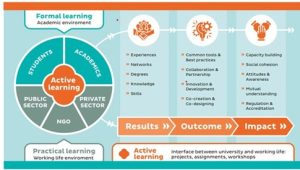
Figure 1. FinTan Innovation Pedagogy Model (Ntulo and Rajala, 2020)
FinTan Innovation Pedagogy Model is a mixture of teaching and learning approaches from Finnish and Tanzania. However, it is generally based on active interaction between instructors, students and the community (i.e. public sector, Non-governmental sector and private sector) during the learning process.
Although the active teaching and learning approach is common, this model is unique in the sense that it places particular emphasis on working life experiences acquired by students through practical working life assignments. This interpretation of active teaching and learning is supported by Freeman et al. (2014), who define active learning as “engaging students in activities that promote analysis, synthesis and evaluation of class content, rather than solely delivering information through lectures”. Basically, linking students with working life is the backbone of the FinTan Model. This learning approach delivered positive results during the IRIS project and has done the same in other parts of the world where it is practiced. For example, in North Carolina the approach has been acknowledged to have a positive impact on students’ learning to the extent that laws have been enacted to compel institutions to establish business advisory councils for the purpose of advising them on the most appropriate and advantageous way of implementing the model (Harper, 2018).
Scaling Up of the FinTan Model
IRIS set a foundation upon which SUSIE project scaled up upon. The scaling up of the FinTan pedagogy model to partner institutions of SUSIE project (TUDARCo, MoCU and MWECAU) had the same objectives as it was in IRIS project of strengthening learning outcomes of university students by improving the theoretical learning and connecting theoretical knowledge with practical knowledge through real life project activities. However, SUSIE extended the FinTan pedagogy model from conventional mode to on online settings for the purpose of building capacity of human resource that can meet current needs of the society, working life and employability. It is imperative to note that, although online learning is not new concept in universities, it gained emphasis during and after COVID pandemic (Dos Santos, 2022). In fact, the COVID challenges caught universities in many developing countries unaware because they lacked required infrastructure and human resources to carry out online learning. Nevertheless, online learning continued to be part and parcel of normal teaching and learning in universities in the world. The human capacity gap that exists in online learning areas was the gap that SUSIE intended to address among other things.
However, knowledge of application of the FinTan pedagogy model in conventional settings was regarded as the basis for application in an online setting. For that matter, before jumping to active online learning, the conventional FinTan model was introduced in partner institutions through training workshops held in each university to build up the foundation of active teaching and learning skills and to promote industrial ties to lecturers who predominantly uses lecture as their teaching method.
The conventional FinTan training concentrated on the application of various active teaching and learning methods in physical classrooms and how to link between classroom lessons with real life experience in the industry. The idea behind this approach is that learners must actively engage in learning in order to perfectly understand the theoretical parts of the lesson before engaging the community in the learning process. This type of learning is based on constructivist theories of learning which emphasises the learner’s use of prior knowledge to connect to new knowledge; by doing so, the learning enhances higher order thinking skills through production and articulation of knowledge. Thus, active learning assignments and projects have to be designed in a way that harnesses the current understanding of learners, makes it explicit and allows integration of prior knowledge into current understanding. This helps students move from the level of memorisation to understanding, improving retention and recall and subsequently promotes creativity, innovation, critical thinking and problem solving skills.
Guided by the thinking outlined above, various active teaching and learning approaches ranging from individual to collaborative, inside to outside the classroom and technology to non-technology-based techniques were shared, discussed and tried out during training. The target was to share and exchange experiences on various techniques and their applicability in Tanzanian university contexts. For example, lecturers who use active teaching techniques in large classes shared their experiences.
Alongside active teaching and learning techniques, linking academia with industry was also greatly emphasised in the training. Discussions on how classroom learning should be linked with industry captivated most of the participants because this is not a common practice in the learning environments of most Tanzanian universities. However, the phenomenon can seem complex to novice implementers as it requires integration of the two different working environments in which the two realms operate. But evidence on its growth worldwide is encouraging. For example, findings on the global trend of linking academia and industry show the collaboration is on the rise (Elsevier, 2021).
In SUSIE as opposed to IRIS, the FinTan model was piloted in the three partner institutions. The pilot phase involved instructors applying active teaching and learning methods in real classrooms and encouraging community engagements in the learning process. The classroom and the community were connected through student’s assignments and projects. Most of the assignment and projects were strategically designed to link classroom knowledge with practical applications in real life. Through the projects, students in collaboration with the respective communities, identified and addressed specific community needs and challenges. By doing so, students acquired knowledge and skills in their subject areas and te community found solutions to the challenges they were encountering.
Each partner university selected courses to pilot the FinTan approaches. The courses, topics and subsequent assignments and projects were carefully selected to ensure that they were not only academically relevant but also tailored to address specific community needs. Student’s execution of the projects involved a range of activities such as carrying out needs assessment, collecting and analysing data to determine the community need and co-creating applicable solutions. The statistics summarized in Table 1 below provide an overview of the students and community members engaged in students’ projects.
Table 1: Statistics on Student-Community Interaction in the SUSIE project.
| S/N | Name of university |
No. of students Involved |
No. of community mem- bers reached | ||
| Male | Female | Male | Female | ||
| 1 | TUDARCo | 128 | 143 | 58 | 53 |
| 2 | MWECAU | 19 | 16 | 22 | 18 |
| 3 | MoCU | 72 | 51 | 46 | 62 |
For example, at TUDARCo, a community of upcoming young musician became involved in student’s learning. on Intellectual Property Rights course, students studying for a Bachelor of Laws interacted with upcoming young musicians and discovered that they were victims of the loss of their intellectual property rights in a variety of ways. They co-created a solution that involved training on intellectual property rights in the music industry and the protection of such rights.
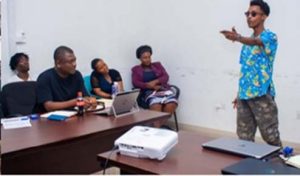
Figure 2. A young and upcoming musician singing a song during intellectual property rights protection training for upcoming musicians at TUDARCo (SUSIE project).
At MWECAU students studying for a Bachelor of Education engaged in similar university- industry collaboration whereby secondary school teachers around Moshi town were engaged in student’s learning process. As part of a classroom project, student conducted a needs assessment which led to a discovery that secondary school teacher’s needed capacity building on test construction, procedures and assessment techniques and they collaboratively devised a solution. In addition, business students at MWECAU worked with the business community and identified a need to increase turnover during low tourist seasons as turnover tends to be low in that season. As a solution, a project to improve the digital marketing skills of small entrepreneurs around Moshi town to enable them to sell online was implemented by students.

Figure 3. Moshi town teachers engage in hands-on activities during capacity building training (SUSIE project, 2022).
Similarly, MoCU students also carried out assignments and projects that linked them with the community.For example,students studying Community Economic Development linked with micro-entrepreneurs around the university as part of the classroom assignments. During their interactions, they noticed that the entrepreneurs lacked business planning skills. The students in collaboration with the respective entrepreneurs organised for a training workshop where micro-entrepreneurs were trained on how to develop business plans as well as monitor and evaluate the development of their business. Furthermore, marketing and entrepreneurship students were involved in supporting entrepreneurs in the branding and promotion of their products online.
Feelings and Experiences
Both lecturers and the students who participated in the project acknowledged that this kind of learning is extremely important as it allows students to acquire multiple skills which they would otherwise not have been able to acquire through normal classroom sessions. They also built familiarity with working life. Referring to this type of learning, Tumuti et al (2013) commented in reference to a partnership between Kenyatta University and Equity Bank;
”The students’ benefits from the program are twofold. First, the students are expected to benefit through the training seminars on contemporary issues they are likely to encounter in the communities as they give their service. The seminars and through their real interaction with the communities they serve which makes what they learn during the training seminar a reality. The served communities are expected to gain knowledge and skills from their interaction with the University who are eager to serve the communities they come from. The interaction between the students and their communities help to reduce the gap that exist between them and further familiasize students with the real life in the community where they will live and work after they complete their studies.”
Students who took part in the pilot course and had the opportunity to interact with the community described their experiences of working with people from industry as extra- ordinary. A student from TUDARCo who participated in a project with young upcoming musicians on intellectual property rights, commented that;
Interacting with the community when you are still a student is an eye opener to the opportunities and challenges ahead of you when you are done with your studies. So, it is really important for students to get this kind of opportunity for the purpose of getting themselves ready for working life.
Lecturers also commended the FinTan teaching and learning approaches.They specifically acknowledged their effectiveness in engaging the industry in students learning processes. In a similar context, Ahmed et al (2022) emphasise that students learn most of their skills in the field. Skills such as communication, leadership skills, ethics and professionalism, quality assurance, technical writing and project management are more easily learnt through practice in industry than theoretically in class. Therefore, student’s exposure to the industry needs to be viewed as equally important as attendance in class.
Members of the community who interacted with students also described their feelings. During interaction when a community of street food venders were invited for a training workshop at the university campus, one of the vendors said;
I never in my life imagined that I would one day enter the university compound. So, to me this is a great thing. I have also learnt a lot of things that will help me as I do my work.
The sentiment above sums up the mutual benefits of university-community ties from individual to institutional level. It is indeed obvious that industry accrues enormous benefits from collaboration with universities. One notable benefit is the development of new ideas and innovation. According to Tian et al (2022), enhancing innovation is one of the main reasons that push industry to collaborate with universities as it is a major contributing factor to economic development at all levels of the economy.
Conclusion
In this context, universities and industry depend on each other and therefore must strive to maintain their mutually beneficial relationship. However, universities must take the lead in promoting collaboration especially when the curricula are designed in a manner that allows integration of industry into students learning. The IRIS project and subsequently SUSIE project were basically aligned to this purpose, but with slight different perspectives. In general, the first project paved the way for the latter in terms of active teaching and learning and industrial engagement with the learning process in both conventional and online settings.
References
Ahmed, F., Fattani, M.T., Ali, S. R. and Enam, N. R. (2022). Strengthening the Bridge Between Academic and the Industry Through the Academia –Industry Collaboration Plan Design Model. Frontiers in Psychology, 13, 875940. https://doi.org/10.3389/fpsyg.2022.875940.
Dos Santos, L. M. (2022). Online learning after COVID pandemic: Learners’ motivations. Frontiers in Educa- tion, 7, 20th September 2022. Accessed on 23rd Nov 2023 at https://doi.org/10.3389/feduc.2022.879091.
Harper, A. (2018). Schools needs industry input to help students connect learning to the real life. K-12 Dive Newsletter. Accessed on 21st Nov 2023 at https://www.k12dive.com/news.
Tian, M., Su, Y. and Yang, Z. (2022). University-Industrial collaboration and firm innovation: an: empirical study of the biopharmaceutical industry. The Journal of Technology Transfer, 47, 1488-1505. https://doi. org/10.1007/s10961-021-09877-y.
Tumuti, D.W., Wanderi, P.M. and Lang’at, T. (2013). Benefits of University-Industrial Partnerships: The case of Kenyatta University and Equity Bank. International Journal of Business and Social Sciences, 4(7).
Active Methods in Online and Blended Learning
Introduction
Presently, the world is marked by volatility, uncertainty, complexity, and ambiguity. It is therefore imperative for individuals and institutions to develop capacities that can counteract the situation and eventually turn challenges into opportunities. Across all sectors and industries, there is a growing need for creativity, resilience and innovative problem-solving skills, coupled with the ability to manage rapid changes, make high-risk decisions, and quickly respond to problems (OECD, 2016). In order for Higher Education Institutions (HEIs) to be able to respond to these needs, the teaching and learning focus should not only be on guiding students to acquire specific technical knowledge and subject-related skills, but also on helping them develop skills relevant for working life, fostering innovation and improving their employability.
This chapter focuses on active teaching and learning approaches in online settings as a response to the uncertainty and disruption of conventional learning that was experienced during and after COVID 19. However, it is also a response to the demand for relevant skills, innovation and employability of graduates who have studied in online environments. According to UNESCO (2020b) online teaching and learning grew exponentially during the COVID 19 pandemic. However, a lot of scepticism also emerged with regard to the quality of the courses in terms of relevant knowledge and skills acquisition and retention. This was the gap that SUSIE project was addressing. For that reason, the emphasis of in the online courses of the SUSIE project was therefore on integration of active teaching and learning components into the online courses with a view to improving the acquisition of skills by learners thereby enhancing employability.
The Justification for SUSIE Online Courses
Currently, the higher education landscape in Tanzania is undergoing transformation in many areas including the introduction of online learning in higher learning institutions (Mtebe and Raphael, 2017). Previously, the mode of teaching in most of the universities and colleges was only in physical classrooms and involved face-to-face interactions between lecturers and students. This traditional mode of teaching has been very challenging due to factors such as the increasing number of students who are currently enrolled in higher learning institutions in Tanzania among others. A major concern has been the outcry from of the industry that most of the graduates entering the labour market are unskilled. On top of that, the COVID-19 outbreak in 2019 also disrupted the conventional teaching and learning in Tanzania just as it did in in many other countries around world. It is indisputable fact that many schools, colleges, and universities in different parts of the world were severely affected by COVID-19. According to the United Nations Educational Scientific and Cultural Organization (UNESCO), over 800 million learners from around the world were affected by this pandemic. One in five learners could not attend school while one in four could not attend higher education and over 102 countries ordered nationwide school closures (UNESCO, 2020b). Due to the challenges posed by the COVID-19 pandemic, many colleges and universities introduced online courses to run parallel to replace the traditional mode courses. This has democratised the education system and provided different opportunities (Anane and Adusei, 2024). Resilience to such turbulences is an essential mandatory requirement to in higher education institutions in Tanzania and other parts of the world alike. However, ensuring the quality of the service in order to meet the demand of the students in online learning is of paramount importance.
It was in this context that, SUSIE envisioned the need to integrate active teaching and learning into the online environment. Indeed, it is about recognising and accepting the fact that students must be actively engaged in their learning and be exposed to working life even if they are studying in an online environment.This will promote equality of online learning by enhancing the learning outcomes and thereby increasing the motivation of the students. For example, active engagement of by online learners will help them to be curious, mindful, and reflective and have the courage to involve themselves and their thinking into discussions with others just like in face-to-face situation.
Thus, as educators, it is critical for HEIs to rethink, how to equip students with the necessary skills and knowledge needed for personal and professional success through online programmes. An environment must be created that allows online learning to be proactive and aggressive in addressing the dynamic environment of the 21st century. In this regard, e-learning should place learners at the centre of the learning process and recognise that today’s youth, as future adults, have the right to acquire the diverse range of skills and competencies referred to as 21st century skills.
Generally, online learning is justified by the many other advantages it offers. One of the primary advantages is the accessibility and the construction of learning (Pinto & Leite, 2020). Learners from different diverse backgrounds and geographic and socio-economic statuses can access high-quality education without any geographical constraints. For example, students with disabilities, rural students and students with parental responsibilities can still have access to quality higher education (Renes, 2015).
Furthermore, online learning involves a high level of flexibility with learning materials and lectures are accessible at the convenience of students themselves. This enables them to balance their educational activities, employment and other family issues. Similarly, in online environments there is a possibility for the diverse course offerings. Online platforms can host a plethora of courses covering a broad spectrum of subjects. This promotes the growth of the different disciplines which can imparts different vocational training and enhance personal development.
Moreover, online courses are cost-effectiveness. They are cheaper compared to the traditional mode of teaching. The traditional mode of teaching which is also referred to as brick-and-mortar education, sometimes requires students to incur the costs of commuting, accommodation as well as other expenses associated with attending as physical campus. The other advantage of an online platform is that it promotes the use of interactive learning tools such as interactive quizzes, forums, and virtual labs to enhance the learning experience.
Facilitation of Active Teaching and Learning in an online Settings
Effective facilitation of the online courses and especially when using active teaching and learning methods requires adequate knowledge and skills. The SUSIE used a cascade strategy to train teaching staff. According to Boylan and Bett (2016), the cascade training strategy is a way of training many people in a large organisation. A few facilitators from partner institutions in Tanzania (i.e. TUDARCo, MWECAU and MoCU) were trained on how to facilitate active teaching and learning in online classes as trainers with a view that to the knowledge trickling up to as many facilitators as possible. Certainly, from 19 participants the knowledge on active teaching and learning in online environments has cascaded from the 19 participants to many academic staff in all partner institutions in Tanzania.
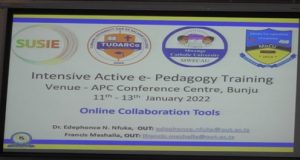
Figure 1. Training on active online teaching and learning methods for SUSIE partner institutions in Tanzania (SUSIE project, 2022).
Nearly all participants were novice users of the online platforms with limited experience as facilitators. This speaks to the relevance the training but also highlights the challenges involved in what it had to take to introducing participants to a completely new environment they had never been. However, active engagement throughout the training yielded positive results. Specifically, the training covered preparation of on-line course syllabi, designing and development of materials for on-line courses, the use of various on-line learning tools to actively engage and motivate students to learn and evaluation of students learning in on-line settings. These topics addressed from a theoretically and practical standpoint. The theoretical part laid the foundation for practical or hands-on learning. Nevertheless, it was the hands-on activities which were most exciting. These practical exercises provided participants with the chance to apply their theoretical comprehension. Both individual and team learning was used. During the teamwork, participants had an opportunity to share their understanding, ask, argue or challenge each other and thereby reinforce the knowledge while individually participants were tested if they could perfectly do independently what they did together in teams and to view them as more effective as learners were fast, with members prompting each other to practice various skills. Although individual hands-on activities were slower, but learners appeared to be more focused and deeply concentrated on the activities.
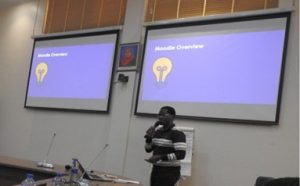
Figure 2. Introduction to active online teaching and learning through the Moodle LMS (SUSIE project, 2022).
Although there are many e-learning platforms, the SUSIE project focused on the Moodle Learning Management System. Moodle is a popular and preferred online learning management system in many places, and this is likely because it is an open source and free of charge. For example, in South Africa, the University of South Africa, University of Cape Town and University of KwaZulu-Natal have adopted the Moodle Learning Management System and have made it compulsory for both first students and lecturers (Mpungose, 2013). Moodle platform was selected based on its flexibility and ease of use for both teachers and participants. It allows instructors to create content and to engage and interact with students. Also, Moodle provides a range of assessment tools (quizzes, assignments, feedback and interactive activities) that can be used to evaluate learners’ progress.
Besides learning the basic knowledge related to navigating in the Moodle platform, the focus and central concern of the training was on setting up an online course on the Moodle platform, including the course structure, learning materials and activities. More specifically, the training emphasised on using interactive and collaborative tools and features available on the platform to make the teaching and learning active. The learning also involved integrating other platforms into the Moodle such as Zoom meetings, Dropbox, Google Drive and Google Docs into Moodle to facilitate active teaching and learning. This was important because in order to makes online classes active and interactive, facilitators must make full use of these features. For example, Sweetman (2020) argues that, for an effective synchronous online session to happen, the platform used should have features like audio and video sharing for instructors and students, screen sharing, virtual hand raising, a small group discussion format breakout, chat, crowd-sourced questions and annotation. Similarly, Watkins (2005) emphasises that;
E-learning activities can turn rather dull online experience into entertaining, attractive, meaningful and valuable learning experience for students. Generating the creative ideas for online activities does not require long hours of meditation. By using adopting of activities from the traditional classroom along with imagina- tive ideas that takes advantage of the unique online technologies, you can create e-learning courses that will excite and engage students while accomplishing important course objective.
As mentioned above, the design of an online course may borrow some active methods from the conventional teaching and use technology to implement these in an online environment. In this regard, knowledge on active teaching and learning in conventional environments was considered essential for effective implementation of the active online courses. Such blending helped participants to easily understand and change their attitude towards online teaching and learning. Similarly, the feelings and belief that courage that online teaching and learning is possible was highly influenced by the facilitators, who were all well informed and experienced on online and distance learning as they were all sourced from the Open University of Tanzania (OUT). It is worth noting that, the Open University of Tanzania is a pioneer of distance and online teaching and learning in Tanzania, and thus getting facilitators from OUT was an assurance of the best service.
The spillover effects of the training in the three partner institutions were remarkable as each institution conducted a number of training sessions for academic staff who were trained to design, develop and teach an active online class. A total of 65 teaching staff from the three partner institutions were trained through inhouse training which covered various topics such as preparation of online course structure, designing and development of the training materials and the use of the Moodle platform for online teaching. However, the emphasis was on the application of the active teaching and learning methods and features.
There were slight differences from one institution to another in terms of the involvement of the academic staff in the training and on how the training sessions were conducted. For example, at Mwenge Catholic University (MWECAU), the first training session involved postgraduate teaching staff from the faculty of education while the second training session involved representatives of the academic departments. At Tumaini University Dar es Salaam College (TUDARCo) the invitation for the training was open to all academic staff even though not all of them managed to attend. In addition to that, TUDARCO organised two other trainings sessions on TUDARCo Moodle orientation. Teaching staff also had to train their students on their respective courses and classes on how to use Moodle as students.
Moshi Cooperative University (MoCU) had a similar experience. However, they started their journey in a different way. They conducted a survey on teaching and learning methods to determine the most commonly used methods. The findings from this baseline survey confirmed that the fact that lecture methods is the dominant method used in higher learning institutions. Other methods used includes question and answer, seminar presentation, case study and group discussion. The practical learning approach included, project write-ups, tutorials, storytelling, group counselling, industrial visitation/field visits, collaborative learning, hands-on activities, and guest speakers. Regarding exposure and access to online studies, the findings revealed that only 30% of the learners had exposure and access online studies. The findings justified the need for inclusion of both active teaching and learning methods and online studies.
Consequently, a number of training sessions were conducted for academic staff at MoCU. These were designed to orient the academic staff on the basics of online courses and more specifically on use of the active teaching and learning methods in online environments. Most of the sessions consisted of inhouse training internal and external facilitators. However, incredible support was provided by the ICT staff who provided support to teachers and students on how to navigate and work on the Moodle platform. The SUSIE online course coordinator at MoCU commented enthusiastically;
Currently, three departments use the Moodle platform for teaching, with a focus on using active teaching and learning methods. More departments, lecturers and students are expected to adopt the same approach soon.
The coordinator further emphasised that, changing from traditional learning is possible to e-learning is possible. However, everyone must be committed. Both students and teaching staff must devote time and energy to make it happen.
Practical Application of Online Courses
One of the goals of the SUSIE project was to upgrade the FinTan model from conventional to online mode, from FinTan to FinTan 2.0. (i.e., to transfer the use of active teaching and learning methods from conventional settings to the online environment). To make this happen, academic staff involved in the project were required to design practical short courses, develop and upload learning materials to Moodle and teach using active teaching and learning methods. Thus, different online short courses ranging from two weeks to two months on varied subjects were developed as pilot courses. The short courses were carefully selected based on identified needs and were approved by the appropriate bodies in the respective institutions.
Various approaches were used by the institutions to market the courses to as wide an audience as possible. The turnout for registration varied from one course to another and from one institution to another. However, all the pilot courses had students and were conducted successfully. For example, TUDARCo conducted three courses, namely Screenwriting, Intellectual Property Rights for Musicians and Digital Marketing and Branding. MWECAU also conducted three courses, namely Educational Assessment and Evaluation, Digital Marketing and Introduction to Data Analysis. MoCU conducted four courses, namely Principles of Quantitative Data Analysis Techniques Using SPSS, Quantitative Data Analysis Using STATA, Tie & Dye Techniques and the Practice of Detergent Making. Of the four courses conducted at MoCU, two were delivered jointly with a group of micro-entrepreneurs known as JUWEKAM (i.e., Tie & Dye Techniques and the Practice of Detergent Making), as indicated in Figure 3 below.
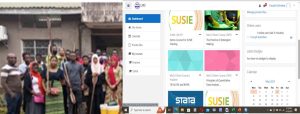
Figure 3. Tools used in the Tie & Dye and Detergent Making online training sessions and the Moodle Platform Interface showing the online short courses on offer at MoCU.
Engaging JUWEKAM in the designing and running of the courses provided a wonderful hands-on experience to students as they had the opportunity to combining online and on-site learning approaches. In fact, this represented typically academia-industry engagement in the blended mode of learning. Academia and industrial linkage are highly encouraged as it helps students to get connected to the industries and acquire real-life experiences which influences their employability. In parallel to that, other active teaching and learning methods applicable in online teaching and learning were used. Similarly, students’ assessments were carried out to assess their learning progress. The available online assessment tools and technologies helped the instructors. The assessment activities used included quizzes, drag-and-drop activities, game-type activities, peer evaluation and review, dialogue simulations, assignments and online examinations.
The short courses were later evaluated to determine how successfully they were conducted. Among other things, the evaluation revealed the need for blended learning to counteract some of the typical challenges of online learning like massive drop out. Fadde and Vu (2014) define the concept of Blended Learning (BL) and differentiate it from Blended Online Learning (BOL) as follows;
Blended Learning (BL) combines traditional face-to-face (F2F) classroom instructi- on (F2F) with online instruction by typically using a learning management system” where as” Blended Online Learning (BOL) is totally online, mixing asynchronous online learning using a learning management system with synchronous online learning using web conference applications.
The type of blended courses recommended here is the Blended Learning (BL). However, Blended Online Learning (BOL) can also be used provided that the challenges encountered in typical online courses are overcome. The most common challenge experienced during blended learning is unaffordable or unreliable internet and lack of reliable electronic devices. In some instances course instructors fail to start their online classes on time due to network problems. In synchronous virtual sessions such as like classes conducted over through Zoom meeting or Google Meet, sometime, students face poor audibility due to weak internet connection. On the SUSIE project, it was discovered that most of dropouts had network issues.
Hands-on Experience
Although online learning is increasingly becoming popular in Tanzania, many academicians have limited with it due to the fact that it was less prioritised before COVID-1919. The situation is also associated with challenges related to technological infrastructure (Anasel and Swai, 2023). In general, in the educational system in most of the universities in Tanzania traditional teaching and learning approaches are dominant (Masue and Innocent, 2020). In this regard, the online courses offered through the SUSIE project were an opportunity for both students and lecturers to gain hands-on experiences. The courses provided a lot of opportunities for instructors to explore teaching and learning approaches in a new environment. The instructors interacted with the Moodle platform to create, organise, deliver, communicate, collaborate and instantly assess students. They also uploaded recorded videos, books and PowerPoint notes for students to engage in self-learning. These activities were completely new to most of the course instructors and therefore engaging in such activities on Moodle platform was a great experience. One instructor from TUDARCo expressed her appreciation when she said;
Online teaching is an amazing activity which I had never experienced before. The interactive activities on the Moodle platform not only engage students into the learning, but also improves their knowledge retention.
Likewise, most of the students who registered for the online courses gained exposure which they never had before.The Moodle platform allowed them to interact with different multimedia resources and other interactive features uploaded by their instructors such as video, interactive quizzes, discussion forums, and downloadable materials. They were also able to access different course materials and lectures at their own pace and from anywhere with an internet connection.
The interactive features and other multimedia resources made students learning much more fun and engaging for students which consequently improved knowledge retention. Moreover, the online courses enabled the students to receive immediate feedback and comments from the course instructors through chart rooms which significantly helped them clarify things and thus improve their understanding. Additionally, online forum provided students with an opportunity to converse using texts thus allowing students and teachers to exchange ideas, comments and responses.
Conclusion
The online courses have profoundly impacted the knowledge and attitude of instructors and students in the higher learning institutions involved in the SUSIE project in Tanzania. On the one hand, the experience was an eye opener to the world of online learning and particularly in the use of active teaching and learning methods in online environments for both instructors and students. On the other hand, the courses provided it has been a platform for knowledge and experiences that supplement and complement the normal classroom knowledge for students. Students of different backgrounds, ages. genders and professions enrolled and studied different courses in the three partner institutions at no cost. It is expected that, the knowledge and skills acquired will help them to start businesses or find employment in public or private sector, enabling them to earn income over the course of their lives and also to solve different challenges in the society which was the primary objective of the project. Through the capacities developed, it is expected that the knowledge imparted will spill over and reach more individuals and that wider society will as a consequence.
References
Anane, G. K. and Adusei, A. (2024). Democratizing online learning platforms: Ghananian Universities expe- rience in promoting equity through accessibility in Online learning. In Designing Equitable and Accessible Online Learning Environments (pp.205-223). doi: 10.4018/979-8-3693-0268-2.
Anasel, M. G. and Swai, I. L. (2023). Factors to determine the adoption of online teaching in Tanzania’s Universities during the COVID -19. pandemic. PLoS, 18(10). e02992065.
Bett, H. K. and Boylan, M. (2016). The cascade model of teachers’ continuing professional development in Kenya. A time for change. Cogent Education, 3(1).
Fadde, P. and Vu, P. (2014). Blended online learning: Misconception, benefit and challenges. Retrieved from https://www.researchgate.net/publication/288009889_Blended_online_learning_Misconceptions_ benefits_and_challenges.
Masue, O. S. and Innocent, W. A. (2020). Applicability of E- learning in Higher Learning Institution in Tanzania. International journal of education and development using information and communication technology.
Mpungose, C. B. (2013). Is Moodle or WhatsApp the preferred e-learning platform at a South African University? First-year students’ experiences. Education and Information Technologies, The Official Journal of the IFIP Technical Committee on Education, 18(4).
Mtebe, J. S. and Raphael, C. (2017). A decade of technology enhanced learning at the University of Dar es Salaam, Tanzania: Challenges, achievements, and opportunities. International Journal of Education and Development using Information and Communication Technology.
OECD (2016). Innovating Education and Educating for Innovation: The Power of Digital Technologies and Skills. OECD Publishing, Paris. http://dx.doi.org/10.1787/9789264265097-en
Pinto, M. and Leite, C. (2020). Digital technologies in support of students’ learning in Higher Education: literature review. Digital Education Review.
Renes, S. (2015). Increasing Access to Higher Education Through E-learning. Open access peer-reviewed chapter.
Sweetman, D.S. (2020). Making virtual learning engaging and interactive. FASED BioAdvances,3(2). UNESCO. (2020b). UNESCO Rallies International Organizations, Civil Society and Private Sector Partners in a Broad Coalition to Ensure #LearningNeverStops. https://en.unesco.org/news/unesco-rallies-interna- tional-organizations-civil-society-and-private-sector-partners-broad
Watkins, R. (2005). Developing interactive e-learning activities. Performance Improvement, 44(5).
Integrating Business Hubs into Higher Education Institutions Curricula in Tanzania
Introduction
Higher Education Institutions (HEIs) all over the world are regarded as critical players in teaching, learning, community services and engagement. They are considered focal points in knowledge and skills acquisition and dissemination. They play a key role as community knowledge hubs and centres of excellence, not only by identifying community challenges but also by devising suitable mechanisms to address these needs. Toigo et al. (2020) and Angrisan (2023) opine that the educational landscape, particularly in Higher Education Institutions (HEIs), is rapidly changing and becoming more dynamic in the face of continued growth in its efforts to maintain its position as a focal point for teaching and learning by providing community services, promoting engagement and becoming a knowledge hub capable of addressing complex community challenges. As they try to maintain their position in the community, HEIs have started to embrace campus hubs as dynamic spaces which enhance creativity, collaboration, networking and entrepreneurial spirit among students, academic staff and community members.
Daub et al. (2020) define a campus hub as a physical space within the university campus that serves as a focal point for innovation, entrepreneurship, collaboration and creativity. They are also called innovation hubs or innovation centres. These hubs help students to close the knowledge gap by exploring their creative ideas, experimenting and testing their prototypes.
The Role of HEI Business Hubs
In recent years, campus hubs have been seen to be at the forefront of education and are gaining in popularity as they become the driving force of innovation, creativity, networking and collaboration in HEIs (Angrisan, 2023; Daub et al., 2020). Campus hubs are a dynamic space that serves as a chemical reagent, speeding up the interdisciplinary nature of the people working in it. These people include students, academic staff members, researchers, mentors and other stakeholders like firms, local and public authorities, national and international organisations and investors (Mtambalike, 2022; Redizman et al., 2022; Angrisan 2023). According to Spigel (2020), campus hub stakeholders may include service providers, political actors, business actors, educators, financial intermediaries, development agencies and professional firms. Campus hubs empower students and other actors to explore their innovative ideas, experiment with available campus hub information and communication technologies, and prototype their services and products in order to come up with tangible outputs. Campus hubs nurture creativity, entrepreneurial spirit, and knowledge exchange.
According to Angrisan (2023) and Meyer et al. (2020), campus hubs play a critical role in the growth of the local economy because they enhance innovation, creativity and knowledge transfer at grassroots level. Radziwon et al. (2022) and Good et al. (2019) point out that campus hubs act as technology transfer vehicles within HEIs and outside the campus, forming a bridge between student projects and industry.
Campus business hubs provide a conducive working space where students can share their brilliant innovative ideas, network and collaborate (Johansson, 2024). Hubs provide the flexibility to work at a convenient time (Howell, 2022). They provide students with shared facilities and equipment like Wi-Fi, routers, printing facilities, photocopying services and projectors, among others (Trembley &Scailleres, 2022), helping them create cost effective and efficient ways of fulfilling their innovative dreams, inspiring one another and working creatively (Gauger and Strych, 2021; Kraus et al., 2022).
Overview of Business Hubs in the SUSIE project
Unemployment in Tanzania, particularly among young people, is a reality which is aggravated by the gap between academia and industry. Among the myriad initiatives intended to address the crisis, youth engagement in the entrepreneurial sphere to exploit existing opportunities is critical. For instance, a National Entrepreneurship Training Framework was created in 2013 to develop didactic principles for entrepreneurship training in Tanzania with the goal of fostering entrepreneurship in formal education.
The Tanzania Development Vision 2025 laid out the goals this framework was designed to help achieve. In cooperation with the Tanzania Commission for Universities (TCU), the International Labour Organization (ILO), the Tanzania Institute of Education (TIE), the National Council for Technical Education (NACTE) and the Vocational Education and Training Authority (VETA), the Tanzanian National Economic Empowerment Council developed this framework to harmonise the various approaches and contents of entrepreneurial education. Aside from mandates related to specific state policies, Tanzania has supported entrepreneurial education through a number of donor-funded projects such as the Norwegian Agency for Development (NORAD), the United Nations National Industrial Development Organization (UNIDO) and the Netherlands Initiative for Capacity Building in Higher Education (NICHE), to name a few. Initiatives to encourage entrepreneurship among Tanzanian adolescents and women have also been launched by organisations, such as the ILO’s Know About Business (KAB) programme. Modules for instructors, young people and teachers have been established through these programmes, as well as initiatives that take the shape of training and entrepreneurial education.
Various local and international organisations have assisted institutions of higher learning in the area of building hubs and accelerator facilities in Tanzania. As part of the SUSIE project, Dar es Salaam Tumaini University (DarTU), Moshi Cooperative University (MoCU), and Mwenge Catholic University (MWECAU) established business hubs aimed at increasing the chances for local micro-entrepreneurs and students to launch and/or grow their businesses with emphasis on innovative ideas grounded on but not limited to the curriculum they study, accessibility in classrooms and collaborative learning, all of which greatly promote the development of social value. Improving the interactive learning environment is critical to fostering a dynamic and engaging educational environment. Hubs in higher educational institutions promote active learning, increase engagement, and encourage student success (Orel and Bannis, 2021). With a renewed emphasis on interactive learning, students find a centralised area where they can gather, exchange ideas and work on their projects. In the long run, students become lifelong learners. Based on this perspective, the Sustainable Business and Employability through HEI’s Innovative Pedagogy (SUSIE) project, spearheaded by Turku University of Applied Sciences in Finland, sought to create sustainable business learning environments involving the establishment of business hubs by each partner institution in Tanzania – TUDARCo, MoCU and MWECAU. Apart from academic success, these hubs created an avenue for students to engage with business, foster entrepreneurial knowledge and skills, and most importantly gain practical knowledge and skills that can bridge the gap between academia and industry, thereby making them more responsible and relevant members of society. Students’ business abilities were given careful consideration in order to ensure that new ventures were viable and responsive to societal or market demands. These hubs supported students in transforming their innovative business/ entrepreneurial ideas into reality through mentorship/coaching and by providing them with necessary resources like physical premises, equipment, mentors and coaches. Furthermore, these hubs served the purpose of assisting students to learn, grow, expand or scale up already launched businesses while linking with the circular economy – a phenomenon that was underscored in students’ and micro-businesses’ hub operations.
These institutional hubs have been designed in such a way that each has an open working space where members can work in teams or individually for the purpose of ideation or co-creating things together. They also have private customisable offices for services or products being developed and a separate office for a hub manager, as suggested by Johnsson et al. (2024) and Grazian (2020).
Campus Business Hub Management and Organisation
Benchmarking is a critical tool for hub management to define goals, measure performance, identify areas for improvement, effectively allocate resources, manage risks and demonstrate competitiveness. Hubs can achieve operational excellence and long- term success by taking advantage of benchmarking insights. To better understand how hubs are organised and operate, benchmarking is key. TUDARCo staff visited three local hubs– the Buni hub owned by the Tanzania Commission for Science and Technology (COSTECH), the University of Dar es Salaam Innovation and Entrepreneurship Centre (UDIEC) and Seedspace. Moshi Co-operative University and Mwenge Catholic University staff visited Anza Hub for the same purpose.
Insights obtained from benchmarking were complemented by a pilot cohort in each institution (TUDARCo,MoCU and MWECAU).The pilot cohort provided practical experience on how hubs should be organised and how their operations should be coordinated. In accordance with the context of each institution, piloting further provided room to identify and understand how to address several challenges that could present themselves in the actual running of business hubs. Furthermore, the shared pilot experience among the three partner institutions was motivation for each institution to make improvements for the successful running of its respective business hub.
The organisation and operation of business hubs can be comprehended through the context, input, process, output and outcome model. Context refers to the external environment that influences the hub’s operations and objectives. In the case of the business hubs established in the partner higher education institutions, it was crucial to understand inter alia the university vision and mission statements, the project’s results framework, the hub goals, the stakeholders involved, the broader ecosystem in which the hub operates including trends in entrepreneurship education, industry/labour market demands for innovation, and regional and economic development priorities. The input refers to the resources and infrastructure support available to the hub to achieve its objectives, including financial resources, human resources such as mentors, physical facilities and equipment.The process refers to activities, procedures and workflows within the hub. Training, coaching and mentoring are examples of typical activities which took place in the hubs. The major university campus business hub activities under the SUSIE project included training and mentorship programs offered to students. The output includes tangible results such as students launching start-ups, developing products and establishing collaborations, as well as intangible outcomes such as knowledge transfer, skill development and community engagement. The outcome is the actual state of change experienced by the students and micro-entrepreneurs after undergoing the hub processes; for instance, students’ employability was enhanced after being supported in the hub. Subsequent impacts will more generally be felt through societal transformation. Figure 1illustrates the Input, Process, Output and Outcome relationship of the SUSIE business hub organisation.
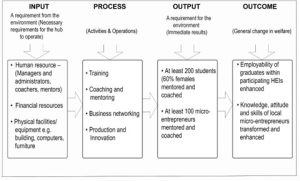
Figure 1. SUSIE Business Hub Organisation Model. Source: Adopted and Modified from CIPP model (Kellaghan & Stufflebeam, 2003).
Campus hub management can vary from one institution to another. However, it is recommended that the following positions be established and filled for effective running of hub operations.
- Hub Manager – appointed by Vice Chancellor/Provost
- Assistant Hub Manager – appointed by Vice Chancellor/Provost
- Administrative Officer – appointed by Vice Chancellor/Provost
- IT personnel – appointed by Vice Chancellor/Provost
- Office Secretary – appointed by Vice Chancellor/Provost
Student Pathway in the Business Hub
The student pathway in the hub means the stages or milestones to be reached over the period the student engages in hub activities. This pathway includes three key stages: selection and orientation, mentorship and graduation (student exit).
Selection and Orientation
After the university community has been adequately informed about the hub within the institution, an invitation is issued for applications from members, mainly students, who wish to engage in hub operations. This can be achieved through advertisements on online platforms such as social media and institutional websites, and through offline methods such as pinning information on notice boards. Students may apply as individuals or groups. Application forms should include key student information that can inform decisions in the selection process. This includes students’ full names, gender, faculty or school, contact information, year of study and a brief description of their business idea. Both applicants with and without business ideas have the opportunity to be selected provided they meet the predetermined criteria. Prior business or entrepreneurial experience is an advantage but is not mandatory.
Upon receipt applications are subjected to a review and selection process by a designated team of hub experts. To ensure objectivity, the selection process is guided by certain predetermined criteria. Typical selection criteria for applications can include the novelty or innovation in the idea, number of ideas per student or group, cost implications, practicability, how the idea is related to the student’s field of study in the university (primarily to enable credit accumulation), the expected time needed to realise the idea, availability of mentors and nature of hub support needed, and the student’s level and year of study. Although selection is based on merit, another key consideration in the selection process is gender equity; a reasonable number of both male and female students should be selected for the hub. That is to say, it is important to be conscious of and responsive to gender issues during the selection process. Once students have been selected for the hub, they are oriented on how the hub operates and clearly informed about the purpose of the hub, the kind of support available, the rules and regulations regarding use of the hub space, etc.
Mentorship, Coaching, Training and Forums for Students
Academic staff from different faculties or schools in the respective partner institutions were student mentors. That is to say, the existence of hubs in universities can hardly be separated from the existing faculties or schools and their respective departments from which the academic staff are solicited. Nonetheless, seeking mentors from outside the university might also be beneficial in terms of providing students with the necessary support. Again, the identification and involvement of academic staff in hub operations is determined by but not limited to their expertise, which is key to their potential to mentor students. This is also the case for mentors from outside the university. The involvement of academic staff in hub operations requires them to possess an adequate awareness or understanding of the essence of business hubs in higher education institutions, how these avenues operate and most importantly the mentorship role which staff are expected to assume. As such, awareness raising for academic staff on said matters is paramount. Once academic staff members have been considered and identified by a team of hub experts as potential mentors, their readiness and commitment to provide guidance, support and advice to help mentees (students) navigate the challenges of launching or growing a business while still at university is very important. The students, meanwhile, are expected to be exceptionally committed to working on their ideas and ready to be guided by the mentors. Students should normally be incentivised to work on ideas related to their fields of study. This strategy is very effective in linking theory (what they learn in class) and practice (what they do in the hub). In addition, the university business hub presents students with the opportunity to develop their business or entrepreneurial skills around what they learn in their respective fields, to launch start- ups, solve societal problems by providing a needed service and in the long run address the unemployment challenges they could potentially face.
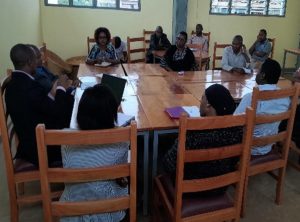
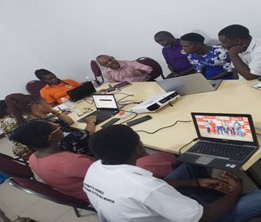
Figure 2 and 3. Meeting with mentors at MWECAU (up) and DarTU (low) Innovation Hubs. Source: SUSIE project (2023).
For mentorship of students to be successful, planning is vital in order to avoid the frustration of doing tasks at the last minute or when deadlines are approaching. Students and their respective mentors need to have a plan that specifies milestones and the expected timeframes for each to be achieved in the course of the mentorship process. It is crucial that these plans be well documented for effective follow-up of the entire mentorship process. These plans ought to be consistent with the hub’s annual action plan. Similarly, the hub action plan, which lays out all major activities for the academic year, ought to be in harmony with the university academic calendar to avoid events coinciding.
Conducting training sessions for students is an effective way to enlighten them about cross-cutting issues such as the circular economy and their potential to venture or engage with these issues in order to address societal challenges and at the same time exploit the opportunities that come with such engagement. Training complements the mentorship that hub students undergo. Training sessions are also important avenues to raise more awareness among students and staff of the role of university business hubs in achieving such purposes. Although most training sessions in the project partner institutions (TUDARCo, MoCU and MWECAU) were organised and facilitated by personnel (experts) from within, certain training workshops also engaged facilitators from outside these institutions as partners in the ecosystem. In the SUSIE project, a series of training workshops was facilitated by experts from notable project partners – Sahara Ventures, Zaidi Recyclers, Turku UAS and Ethica, among others. To broaden the scope of students’ understanding of cross-cutting issues around the globe, in 2022 hub students from each partner institution participated in the 6th World Circular Economy Forum which was hosted in Kigali, Rwanda.
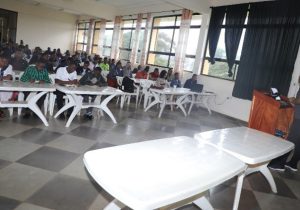
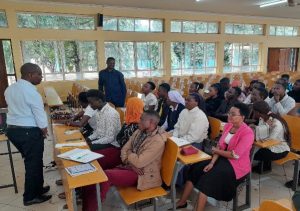
Figure 4 and 5. Joint MoCU and MWECAU Training on Circular Economy delivered by Zaidi Recyclers at MWECAU (up), and Training on University Innovation Promotion delivered by Sahara Ventures at MoCU (low). Source: SUSIE project (2023).
Each of the partner institutions has a hub space, which is a room strategically designated by the university to serve as a meeting place for students and, on occasion, staff to encourage interaction, collaboration and exchange of ideas. While mentoring normally takes place in these spaces, other university facilities with more capacity like lecture rooms can be used to conduct other hub activities like training workshops. The hub spaces, however, offer more comfortable seating and are integrated with technology such as Wi-Fi, LCD projectors, printers, and computers as well as an informal setting with aesthetic design elements. Access to hub resources is also easier for hub members. These hub spaces feature spaces or rooms built particularly to facilitate group work, brainstorming and working together to establish ties and networks. For example, the hubs have tables and chairs that may be rearranged or dismantled for the same purpose. Effective use of these hubs requires proper arrangements to be made by the hub leaders/manager to ensure students have access to the hub spaces while ensuring proper management and use of the facilities and resources at their disposal.
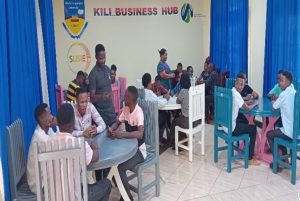
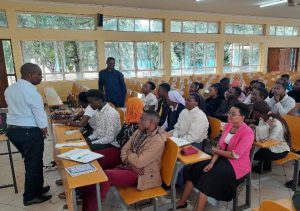
Figure 6 and 7. Students in Kili Business Hub at MoCU (up) and MWECAU Innovation Hub (low). Source: SUSIE project (2023).
Student Graduation from the Hub
Students graduate or exit from the hub after successful mentorship. The hubs in the partner institutions have produced a number of graduates from their respective cohorts. On the one hand, it is expected that at the time of graduation (exit), each student’s innovative business idea should have been transformed into tangible outcome(s) such as a product prototype, finished product or a service (business) to scale up. On the other hand, at this time, students may also have achieved intangible results such as learning skills that make them effective and efficient problem solvers. The latter, although often not recognised as such, are essential for students who are inevitably forced to exit the hub, particularly as a consequence of their study programme ending, e.g., three-year bachelor’s programmes. That is to say, it is important to recognise the significant efforts that students put in not only when they participate in specific hub activities but also over the course of the entire hub process. How long it takes to realise a business idea through mentorship in a business hub can vary among students depending on the nature of their idea. The varying timeframes can necessitate continued mentorship for students who have incomplete results at the end of the academic year but see prospects of further achievement if mentorship continues into the next academic year.
Although the roles of other players in the ecosystem are evident during the training workshops and mentorship, their roles become more pronounced after students have graduated from the hub. More specifically, the roles of these players are crucial for students who have managed to come up with tangible innovations and products to showcase or businesses that require scaling up. At this point, further industry support for these students is critical. Through the campus hubs established ties with partners like banks, companies, government agencies and other potential stakeholders, graduates can be guided to write proposals for funding and provided with more support to start or grow their business depending on the level of their achievement in the business hub.
Linking Theory and Practice through Campus Business Hubs
Providing students with a well-rounded education that prepares them for real-world challenges and opportunities requires linking the theory they learn with practice. The business hubs in the partner institutions (DarTU, MoCU and MWECAU) fostered competence-based learning by allowing students to creatively put into practice the knowledge obtained in class while developing entrepreneurship skills that made them ready to face the unemployment challenge particularly. Nevertheless, students were not limited to working on ideas purely emanating from what they learnt in class. This strategy allowed more room for students to demonstrate their interests and highlight their potential to solve societal challenges while at the same time exploiting the opportunities at their disposal. It is important to note that, while most students who made use of the campus hubs presented creative ideas which needed to be transformed into a tangible product or service, some students already had small-scale businesses that needed hub support to scale up.
Co-creation is central to solving societal challenges. The concept of co-creation,which was originally used in marketing and service science, has rapidly spread to other disciplines such as innovation, branding and production. In essence, co-creation can be defined as a joint, collaborative, concurrent, peer-like process of producing new value. Depending on the context, one can imagine a variety of forms of co-creation with different actors involved/integrated (customers, users, communities, etc.). Multiple perspectives are required to address the issues in the society (Redlich et al., 2019). Embracing co-creation in campus hubs when solving societal problems entails working together with a variety of stakeholders, including individuals, communities, organisations and governments, to tackle difficult situations. This approach acknowledges that no single entity holds all the knowledge, resources, or viewpoints required to effectively address such issues alone. This approach is therefore necessary for optimal solutions to be found to societal problems.
Student Monitoring and Evaluation
Students are regularly monitored in campus hubs to determine the progress they make as they participate in hub activities. Through meetings between hub leaders and students and/or with mentors, challenges and prospects regarding the mentorship or coaching process can be identified and addressed immediately. The use of social media platforms also efficiently serves the purpose of facilitating communication among students and mentors. Subsequently, hub leaders obtain feedback on students’ progress. Students can also be tasked with a requirement to submit regular progress reports documenting their activities, accomplishments, obstacles and future plans in the business hub. Mentors can then analyse these reports to track individual progress. While students make their presentations in the hub to showcase their work, feedback about their progress can be obtained by the hub leaders.
Sustainability of Campus Business Hubs
Campus business hubs serve as a vibrant centre for creativity and innovation, providing physical and intellectual space for students to share knowledge and skills and create impactful solutions to solve community challenges, thus hub sustainability is important (Doub et al., 2020). Several propositions have been made in this regard. Notwithstanding the respective vision and mission of each university and the core functions of universities – teaching, research, consultancy and community service – campus business hubs should be clearly situated in institutional administrative structures to underscore their role in universities and society at large. Continuous improvement of hub operations and spaces by integrating modern or sophisticated technology, among other things, is an effective strategy to ensure the sustainability of campus business hubs. A reasonable fee should be charged, particularly of guests who are interested in using the hub facilities. This fee can be used to fund the business hub’s operational costs. Institutions should continue to provide incentives for trainers, coaches and mentors. Encouraging students to participate in cross-cutting environmental, social and economic programmes that draw the attention of potential actors in the eco-system to hub operations is crucial. Venturing into issues related to waste management, circular economy, water conservation, community engagement, and renewable energy, among other potential areas, can help the hubs remain relevant. Alumni should be linked with trainees (hub students) and be invited to the hub to share their experiences. Where resources are available, stakeholders exit meeting should be held for each cohort. Networking with other business hubs in the country and beyond is expected to provide room for continuous learning from others through benchmarking and sharing of experiences. Furthermore, documentation of the best innovations should be mandatory in every business hub, and innovators need to be linked with successful entrepreneurs. Showcasing of success stories and tangible outcomes in exhibitions can be an effective strategy to ensure the sustainability of campus business hubs. Through exhibitions, other potential players in the eco-system can become interested in engaging with hub activities. Similarly, partnership and collaboration with other university campus hubs, local and central government agencies, non-profit organisations and industry partners to leverage resources, share best practices and implement joint sustainability initiatives can help ensure the sustainability of campus hubs.
Conclusion
It’s crucial not to overlook the significance of campus business hubs. They serve as essential catalysts, not only by furnishing both physical and intellectual environments for students to conceptualize and test their innovative ideas but also by fostering empowerment and motivation. This, in turn, cultivates a cohort of innovative and creative problem-solvers capable of tackling community challenges and generating employment opportunities for themselves and their peers. Most importantly, business hubs allow students to practice what they learn in class to either solve community challenges or turn them into a potential business opportunity.
References
Angrisan, M. (2023). Framing the Main Patterns of an Academic Innovation Ecosystem. Evidence from a Knowledge Intensive Case Study. International Journal of Entrepreneurial Behavior & Research, 29 (11), 109-131. Emerald Publishing Limited. doi: 10.1108/IJEBR-12-2022-1088
Daub, C., Hasler, M., Verkuil, A.H. and Milow, U. (2020). Universities Talk, Students Walk: Promoting Inno- vative Sustainability Projects. International Journal of Sustainability in Higher Education, 21(1).
Gauger, F., Pfnür, A. and Strych, J.O. (2021). Coworking spaces and start-ups: empirical evidence from a product market competition and life cycle perspective. Journal of Business Research, 132, 67-78.
Good, M., Knockaert, M., Soppe, B. and Wright, M. (2019). The Technology Transfer Ecosystem in Acade- mia. An Organizational Design Perspective, Technovation, 82, 35-50.
Grazian, D. (2020). Thank God it’s Monday: Manhattan Coworking Spaces in the New Economy. Theory and Society, 49(5/6), 991-1019.
Howell, T. (2022). Coworking spaces: an overview and research agenda. Research Policy, 51(2), 104447.
Johansson, E., Rådman, E., Raharjo, H., and Bosch-Sijtsema, P. (2024). Identifying and prioritizing coworking member needs. Journal of Corporate Real Estate, Emerald Publishing Limited 1463-001X. doi:10.1108/JCRE-06-2022-0020
Kraus, S., Bouncken, R.B., Görmar, L., Gonzalez-Serrano, M.H. and Calabuig, F. (2022). Coworking spaces and makerspaces: mapping the state of research. Journal of Innovation and Knowledge, 7(1), 100161.
Mtambalike, J. (2022). Diary of an African Hub Manager: Lessons in Growing our Innovation Systems. Thomson Press.
Orel, M. and Bennis, W.M. (2021). Classifying changes. A taxonomy of contemporary coworking spaces. Journal of Corporate Real Estate, 23(4), 278-296.
Radziwon, A., Bogers, M.L.A.M., Chesbrough, H. and Minssen, T. (2022). Ecosystem effectuation: crea- ting new value through open innovation during a pandemic R and D Management, 52(2), 376-390. doi: 10.1111/radm.12512.
Redlich, T., Moritz, M. and Wulfsberg, J. P. (2019). Co-Creation: Reshaping Business and society in the era of bottom-up economics. Springer.
Toigo, T., Wegner, D., Silva, S. and Zarpelon, M. (2022). Capabilities and Skills to Orchestrate Innovation Networks. Management Review,18(2), 129-144. Emerald Publishing Limited 2515-8961. doi:10.1108/ INMR-10-2019-0126
Schaeffer, V. and Matt, M. (2016). Development of Academic Entrepreneurship in a Non-mature Context: The Role of the University as a Hub-organisation. Entrepreneurship & Regional Development, 28(9/10), 724-745. doi: 10.1080/08985626.2016.1247915
Spigel, B. (2020). Entrepreneurial Ecosystems: Theory, Practice and Futures. Edward Elgar Publishing.
Tremblay, D. and Scaillerez, A. (2020). Coworking spaces: new places for business initiatives? Journal of Innovation Economics and Management,31(1), 39-67.
Closing words
This publication encapsulates the essence of the SUSIE project, highlighting its major achievements. The first two chapters emphasise the significant role of leadership in transforming higher education. The authors offer a comprehensive exploration of sustainable leadership, guiding readers from theoretical concepts to practical applications. Sustainability is presented as a holistic model, achievable through commitment, strategic thinking, and a future orientation requiring systemic changes.
Chapter three proceeds from strategic planning to the realm of learning and teaching, underscoring the importance of pedagogical models in higher education. It introduces a shared model that is not only practical but also adaptable, as illustrated in chapters four and five. The FinTan innovation pedagogy model emerges as a versatile tool, enabling an active teaching and learning approach in both online and onsite environments. With online learning becoming integral to Tanzanian higher education, the authors of chapter four advocate for the potential of blended learning models. Additionally, the SUSIE Business HUBs present an open platform where students can confidently focus on developing their own business ideas, enriched with circular economy thinking.
The project’s performance matrix has shown a steady improvement in quantitative indicators. However, beyond the numbers, the qualitative impact has become increasingly visible. Figure 1 below attempts to capture the holistic shift in the educational mindset adopted by Tanzanian higher education. This transformation revolves around a new learning culture where innovative thinking is nurtured through a multidisciplinary approach and diverse local collaborations. Sustainable strategic thinking, along with blended programmes and innovative HUBs, are the flagships of a new era of learning. The once weak signals of RDI potential have now amplified, showcasing a strong future orientation. These advancements mark a profound change in social identity, making it more distinctive, confident, and aware of the positive transformation underway.
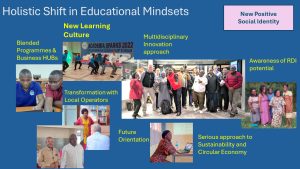
Figure 1. Impact of SUSIE.
The chapters of this publication highlight the development work done by members who have formed the SUSIE family. We have laughed and cried together, learned and grown, and celebrated numerous achievements. SUSIE members have upgraded their skills, graduated, and advanced their careers. A remarkable milestone was the founding of DarTU, Dar es Salaam Tumaini University, a fully-fledged university built on the foundation of TUDARCo. The SUSIE family congratulates DarTU and wishes a prosperous and sustainable future for higher education in Tanzania, Finland, and around the world!
Publication Details
Title: Towards Sustainable Higher Education Institutions in Tanzania: SUSIE Project Experiences
Eds: Ritva Hyttinen, Gideon Ntunga, Getrude Ntulo & Mangasini Katundu
Publisher: Turku University of Applied Sciences / Talk Reports 1
Publication year: 2024
ISBN: 978-952-216-886-3
ISSN 2984-4193
The publication is also available:
Towards Sustainable Higher Education Institutions in Tanzania: SUSIE Project Experiences
Eds: Ritva Hyttinen, Gideon E. Tunga, Getrude R. Ntulo & Mangasini Katundu
ISBN: 978-952-216-874-0 (print)
ISBN: 978-952-216-873-3 (pdf)
Reports from Turku University of Applied Sciences 300
77 pages, 2024
Kuva StockSnap /Pixabay


